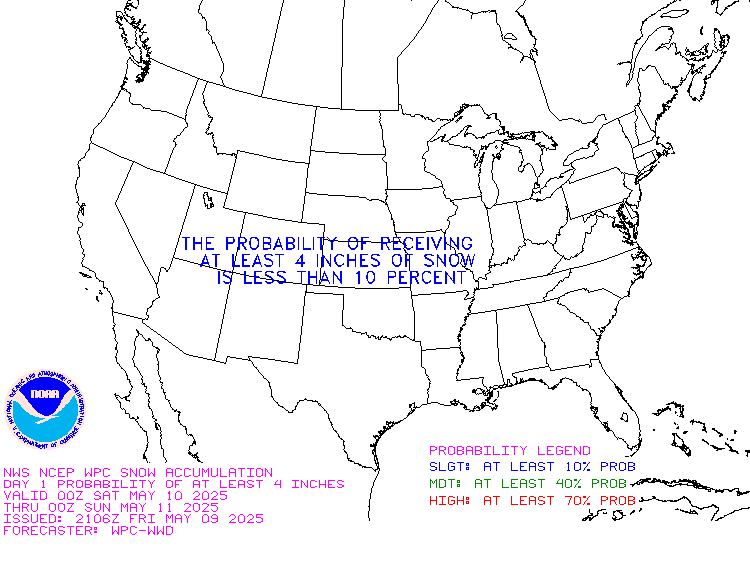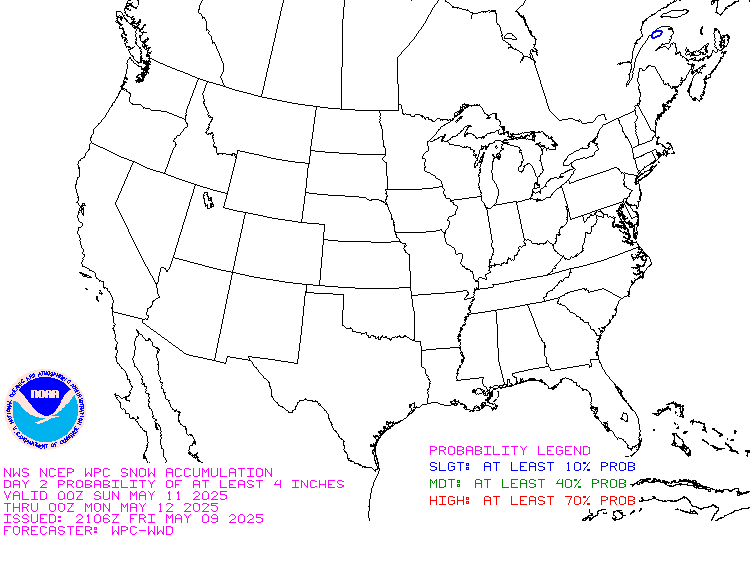This article focuses on what we are paying attention to in the next 48 to 72 hours. The article also includes weather maps for longer-term outlooks and a six-day World weather outlook which can be very useful for travelers.
We start with the U.S. Information. That is the longest part of the article. Then we have a short section on World Weather and then we address the Tropics. When there are tropical storms that might impact the U.S. we provide more detailed information which updates frequently on those storms.
Please click on “Read More” below to access the full report as I have moved the highlights into the body of the report where it is followed by the Today, Tomorrow and the Next Day maps and a lot more. I will try to feature the most important graphic in the lede paragraph on the home page. But there are often multiple maps that are very important so it is best to read the full article. We now have a snow report and it is possible to get a ten-day NWS forecast for the zip code of your choice.
| Notices: We recently published a review of October weather worldwide and you can access that article HERE. And a review of October weather for the U.S. which you can access HERE. We have now published the NOAA Seasonal Update which you can access HERE. This was followed up with the update of the Mid-December Outlook which you can access HERE. What would you like to learn about? Please provide that to me via the comment section at the end of the article. |
First the highlights from the NWS.
Short Range Forecast Discussion
NWS Weather Prediction Center College Park MD
Fri Dec 22 2023
Valid 12Z Fri Dec 22 2023 – 12Z Sun Dec 24 2023…Heavy rainfall and flash flash flooding will continue to impact areas
of southern California today, with the threat gradually expanding into the
Southwest through tonight……Next round of unsettled weather will reach the Pacific Northwest today
then quickly move through the Intermountain West going into Saturday……Snow is forecast to overspread the central Rockies Saturday night
before expanding into the northern Plains by the morning of Christmas
Eve……Unusually mild temperatures will persist across the Plains and Midwest
through the early part of the Christmas holiday weekend…
Now more detail on the 48-Hour Forecast (It is a 48 to 72 Hour Forecast actually)
Daily weather maps. The Day 1 map updates twice a day and the Day 2 and 3 maps update only once a day. These maps update automatically. But if that does not happen, you can get updates by clicking HERE
TODAY (or late in the day the evening/overnight map will appear) (Key to surface fronts shown on maps and you will then also be able to insert a city name or zip code and get a local NWS forecast).
TOMORROW
NEXT DAY
This animation shows how things may play out over the next 60 hours. To update click here.
The NWS Climate Prediction Center’s: Watches, Warnings, and Advisories plus other information can be found HERE. We post at least one of those updates daily, sometimes both. The Highlights are shown in the lede paragraph of this article.
ATMOSPHERIC RIVERS
This tells us what is approaching the West Coast. Click HERE to update If I have not gotten around to doing the update. Here is some useful information about Atmospheric Rivers.
Continuation of the NWS Short Range Forecast. It is updated by NWS twice a day and these updates can be found here
A relatively slow-moving low pressure system off the southern California
coast will begin to gradually accelerate off to the east and move onshore
into the Southwest U.S. by tonight. Deep southerly flow ahead of the low
center will continue to feed moisture-laden air from the subtropical
Pacific Ocean toward southern California today. Heavy rainfall will most
likely be found once again along the wind-facing coastal ranges of
southern California where prolific rainfall amounts had already been
reported in the past 24 hours, with additional significant flash flooding
expected. Urban flash flooding will also be possible including areas of
the Los Angeles basin early this morning. Debris flows and mudslides will
remain likely near burn scar areas and areas of steep terrain. The
Weather Prediction Center has maintained a Moderate Risk of excessive
rainfall for these areas early this morning.As the low pressure system moves onshore later today, the heavy to
excessive rainfall threat will begin to spread east into areas of central
and southern Arizona as well by Friday night and into early Saturday. A
Slight Risk of excessive rainfall is depicted across these areas where
there may be some isolated to scattered areas of flash flooding. Some of
the local slot canyons and burn scars closer to areas of terrain, and also
the dry washes/arroyos over the deserts, will be vulnerable to seeing
these runoff impacts. However, generally much of the rainfall across these
areas should be beneficial.Meanwhile, a cold front will advance inland across the Pacific Northwest
and Intermountain West today and into Saturday, bringing the next round of
low-elevation rains and high-elevation snowfall to the region. The
heaviest snowfall will be over the Washington Cascades, and then
downstream over the northern and central Rockies including the
Bitterroots, Tetons, and Colorado High County.By Saturday night into Sunday morning, the moisture associated with the
cold front is forecast to head toward the central Rockies and will begin
to interact with the moisture lifting northeastward from the southwestern
U.S. system. The San Juan mountains of southwest Colorado will see
impacts relating to the storm system traversing the Southwest, and
multi-day snowfall amounts of 1 to 2 feet will be possible here going
through Saturday. A low pressure system is forecast to consolidate and
strengthen over the central High Plains early on Sunday with snow
expanding northeastward into the northern Plains under strong and gusty
northerly winds. Meanwhile, moisture returning from the Gulf of Mexico
ahead of the system will promote scattered showers and thunderstorms from
the western Gulf Coast up through the southern Plains Saturday night and
especially by Sunday morning. A weaker system will also bring showers
across the southern Plains today, reaching into the Midwest later today,
across the lower Great Lakes on Saturday, before heading toward New
England Sunday morning as a wintry mix.Areas farther east across the central and eastern U.S. will be seeing
generally very mild temperatures through the remainder of the week and
into the start of the Christmas holiday weekend, with areas of the Plains
and Midwest in particular seeing temperatures that will be as much as 15
to 25 degrees above normal. These relatively warm temperatures will be the
result of increasing southerly flow with time and the return of moisture
from the Gulf of Mexico, and some record warm overnight low temperatures
in particular may be set. Expect these warmer temperatures to begin
overspreading the Ohio Valley and Mid-South, with at least above normal
temperatures reaching the East Coast.
Learn about wave patterns HERE.
Below is the current five-day cumulative forecast of precipitation (Updates can be found HERE)
Ski SnowReports
New Feature – Ski Reports. It is difficult to find reports that auto-update on-screen (and they are very long) but these links will get you to them – If you have additional suggestions make them in the comments section after every Econcurrents Article and we may add those links. We will try to not have too much overlap as that can add to the confusion.
Snow Forecasts. And remember this shows natural snow. Ski resorts also make their own snow.
Day 1

Day 2

Additional snow information can be found here and here. The second link provides animations.
Now we look at Intermediate-Term “Outlook” maps for three time periods. Days 6 – 10, Days 8 – 14, and Weeks 3 and 4. An outlook differs from a forecast based on how NOAA uses these terms in that an “outlook” presents information as deviation from normal and the likelihood of these deviations.
Below are the links to obtain updates and additional information. They are particularly useful if you happen to be reading this article significantly later than when it was published. I always try to provide readers with the source of the information in my articles.
| Days 6 – 10 (shown in Row 1) | Days 8 – 14 (Shown in Row 2) | Weeks 3 and 4 (Shown in Row 3 but updates only on Fridays) |
| https://www.cpc.ncep.noaa. gov/products/predictions/610day/ | https://www.cpc.ncep .noaa.gov/products/predictions/814day/ | https://www.cpc.ncep.noaa.gov/products/predictions/WK34/ |
Showing the actual maps. They should now update automatically. The Week 3 – 4 Outlook only updates on Fridays. So below is what I call the Intermediate-term outlook. On Fridays, it extends out 28 Days. That declines day by day so on Thursday it only looks out 22 days until the next day when the Week 3 – 4 Outlook is updated and this extends the outlook by one additional week.
| 6–
10
|
|
|
| 8–
14 |
|
|
| 3–
4 |
|
|
HAZARDS OUTLOOKS
Click here for the latest complete Day 3 -7 Hazards forecast which updates only on weekdays. Once a week probably Monday or Tuesday I will update the images. I provided the link for readers to get daily updates on weekdays. Use your own judgment to decide if you need to update these images. I update almost all the images Friday Night for the weekend edition of this Weather Report. So normally readers do not need to update these images but if the weather is changing quickly you may want to.
Temperature month to date can be found at https://hprcc.unl.edu/products/maps/acis/MonthTDeptUS.png
Precipitation month to date can be found at https://hprcc.unl.edu/products/maps/acis /MonthPNormUS.png
World Forecast
Below are the Day 1 -3 and 4-6 forecasts for temperature and precipitation. Updates and much additional information can be obtained HERE
World Temperature Anomalies
World Accumulated Precipitation
This information is provided by the University of Maine. They draw upon many different sources. There is a lot of information available at the link provided. I have just provided two useful forecasts. There are probably over a hundred different forecasts available from this source.
Worldwide Tropical Forecast (This is a NOAA Product)
This graphic updates on Tuesdays) If it has not been updated, you can get the update by clicking here Readers will only have to do that if they are reading this article much later than the date of it being published.
Information on Tropical Storms can be found HERE. Western Pacific information can be found HERE.
–
| I hope you found this article interesting and useful. |
–
